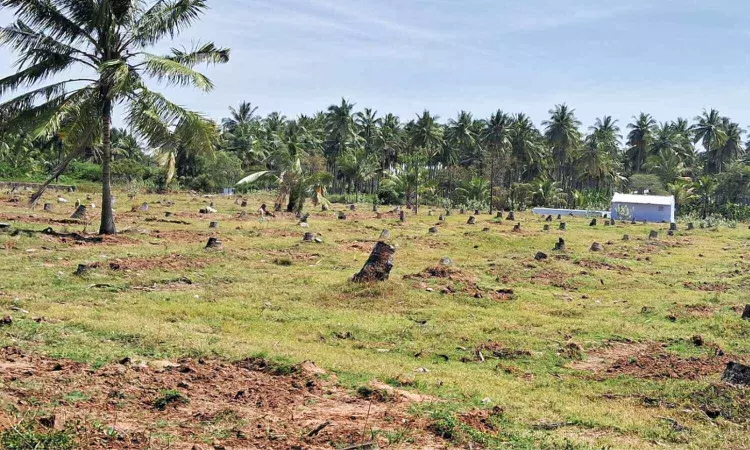Coconut farmers in Kovai hit hard by RWD infection
After taking a severe toll on coconut production in neighbouring state of Kerala, the root wilt disease is spreading across border districts like Coimbatore and Tirupur. Apart from this, farmers also fear that yield will drop further due to existing drought-like conditions

Infected trees felled in large numbers at a farm in Pollachi
COIMBATORE: Pollachi-based farmer Thambu alias Murugaraj looks desolate at the abnormal wilting and paling of leaves in coconut palms at his sprawling grove.
It was just a few months ago that he uprooted more than 50 trees affected by root wilt disease (RWD) with the hope of stopping its spread. Yet, its spread continued in a rapid phase as over 300 trees have now begun to exhibit symptoms of the disease.
The disease-stricken trees show wilting of leaves, paling, yellowing and necrosis of leaves.
“I am extremely worried as I have to remove hundreds of trees. They all are above 40 years and in their prime yielding phase. Because of the disease, the lifespan of a coconut tree, which is up to 80 years, has been cut short drastically and overall yield has dropped by 40 per cent in my farm,” said Murugaraj, who owns a coconut grove spread over 100 acres in Sirukalandai village.
Leaves of disease-infected trees turn yellow and gradually wither
In another farm owned by his in-law R Senthil Kumar in the neighbouring Thekkarapalayam village, a group of labourers toil day in and out to chop the affected trees. “So far, 300 disease-affected trees were cut down, out of the nearly 600 trees in our farm alone. We are completely clueless about the uncontrolled spread of the disease and also about preventive methods. Farmers are trying various pesticides to see, if they help control the disease,” said R Senthil Kumar, whose grove is spread over in an area of over 40 acres.
Though Chief Minister MK Stalin’s announcement to provide a relief package to farmers affected by root wilt diseases has come as a relief, the farmers claimed that the compensation amount earmarked is meagre. The Chief Minister has announced that 14.4 crore will be distributed to farmers to remove the pest-infested trees and three lakh coconut saplings will be distributed free of cost to farmers worth Rs 2.80 crore.
“Officials inspected the affected farms and informed us of giving just Rs 1,000 per affected tree and that too only to a maximum of 35 trees for a farmer. The lifetime value of a tree is much higher and the damage is widespread,” say farmers.
Even though the spread of the root wilt trees was initially restricted in farm areas abutting Kerala, where the outbreak happened, the disease has gradually penetrated interior areas over some time. Strikingly, both the villages are in Negamam, which is over 60 km away from the neighbouring State. Echoing a similar view, N Thangavel, president of the Tamil Nadu Farmers Association said the impact of the root wilt disease is more profound in groves along riverside and those abutting Kerala. Perhaps, the disease has already taken a drastic toll on coconut production in Kerala.
“Currently, the neighbouring state is dependent on Tamil Nadu to meet its demand. Still, prices of coconut remain low here due to the bulk production of copra by over 90,000 metric tonnes in the last two years. Such excess production has resulted in old stock of copra continuing to be in supply. Hence, demand for coconuts to prevails low,” said Thangavel.
Because of the root wilt disease and as well as white fly menace, the yield in coconut trees has dropped by 30 per cent as compared to last year in Pollachi belt. Farmers fear that the yield will drop further by another 20 per cent due to existing drought-like conditions.
They also expressed apprehensions that the outbreak reported widely in Coimbatore and Tirupur districts may soon spread across Tamil Nadu, if proper control measures are not taken.
Meanwhile, following directions from the State government, the VAOs are involved in the process of surveying the number of affected trees in farms located in their jurisdiction.



